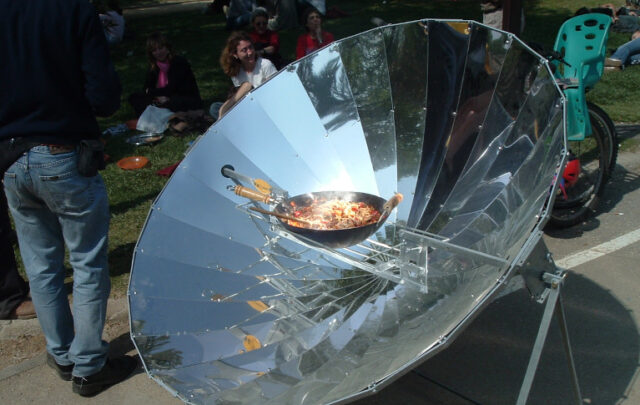NOTE: Images in this archived article have been removed.

Charcoal retains the carbon cell structure of plants from which it is made and, when buried, the carbon can stay in the ground for hundreds or thousands of years. Most fertile soil contains charcoal from ancient or recent forest fires and, until the introduction of synthetic fertilisers, charcoal was widely used by cultivators for enhancing the soil. The most remarkable example of soil modified by charcoal is the deep ‘terra preta’ from a previous civilisation in the Amazon that transformed infertile earth into rich loam.
‘Biochar’ is a new term applied to charcoal that is specifically produced for agricultural purposes. It differs from the familiar charcoal used for barbecues or cooking, which is made from wood in relatively large chunks and retains volatiles that increase flammability. Biochar, on the other hand, can be produced from any biological material and the producer should ensure that it is free of volatiles: wood vinegar, for example, is a valuable by-product as a pesticide and if retained in the biochar would hardly help microbial life! Volatiles and ash could also block the entrance to cavities and make them unavailable to moisture, microbes, fungi and mycorrhizae.

Dr Ravi Kumar, inventor of the Anila cooking stove, standing beside the BiGchar-1000, a continuous-flow pyrolysis unit by Black-is-Green Pty Ltd Australia. Its inventor, Dr James Joyce, is on the left.
Water-holding capacity, therefore, is one of the easiest tests for assessing the quality of a useful biochar because it indicates whether the cavities are open and available. Another indication is the proportion of char to feedstock: a high proportion may indicate that volatiles and ash are retained, adding weight and rendering the char of little, or no, use for soil enhancement. The temperature at which biochar is produced is critical for achieving a high degree of absorption. The cavities give refuge to microbial life that forms a bridge for nutrients to the hairs on plant roots, thus enhancing fertility. It is desirable to mix biochar, before use, with manure, digestate slurry, compost etc. for it to be ‘charged’ and have an immediate effect with plants.
One hope for biochar, therefore, is for increased global food production while permanently enhancing soil. The other hope is that it could help the struggle against climate change.
Carbon dioxide in the atmosphere is mobile. The ‘carbon cycle’ refers to the movement of carbon from sky to earth and back again. Plants capture carbon through photosynthesis then the activity of microbes release it back to the atmosphere; there is about three times as much carbon in soil and plants as in the atmosphere. Over a period of 14 years an equivalent of the entire volume of atmospheric carbon is captured by plants, enters the soil and is eventually released back to the sky. If more carbon can be stored in the soil there will be less in the sky. Human activity is adding a steady stream of carbon to the atmosphere. Oceans have the biggest store of carbon but excess carbonic acid is already a serious problem.
Land has lost carbon since the dawn of history through overuse or harmful farming methods. The Fertile Crescent is an obvious example. Synthetic fertilisers interrupt the carbon cycle and degrade soil by providing nutrients direct to plants. Compaction from heavy machinery is another problem, and rising temperatures are now reducing the ability of soil to retain carbon. It has been estimated that land in the UK may have lost about half its embedded carbon content since the industrial revolution, so there is plenty of scope for increasing carbon in the soil without harming natural systems.
Organic and permaculture cultivation retains carbon in soil. Not much research has been done in temperate climates on further fertility benefits from biochar though, of course, it would also add carbon. Temperatures above 25degC lose more carbon to the air than in cooler climates, giving a greater tendency to desertification. In dry tropical areas the ability of biochar to retain moisture is the first aspect that appeals to farmers, while its ability to improve the structure of soil and provide a haven for microbial life is equally important. Biochar fertiliser is compatible with NPK fertilisers so can be used in a gradual process of reducing the latter in both temperate and tropical areas. In passing it is worth noting that some research indicates soils enriched with biochar curtail the emission of nitrous oxide.

Since the scientific study of biochar is relatively new there are widely differing views as to the part it might play in combating global warming. Much research has gone into some aspects of the technology but there are not many peer-reviewed papers relatingto the performance of biochar in the soil at significant scales or over a number of years. This makes some scientists, concerned for their reputations, reluctant to include biochar as a major element in their recommendations for climate mitigation, whereas the contribution of trees is fully understood. However, the principles set out above indicate that biochar has a huge potential that should attract government funding unrelated to commercial incentive.
Most commentators on climate change talk about reducing emissions. However, global warming is caused by excessive greenhouse gas already in the atmosphere, so merely reducing emissions will not dig us out of the hole. Carbon dioxide must be extracted. Chris Goodall wrote Ten Technologies to Save the Planet about means to tackle climate change; eight are concerned with reducing emissions and only two are for extracting greenhouse gases from the atmosphere. Biochar is one of these. James Lovelock has said biochar in the hands of farmers around the world may be our only hope. Others suggest it may play a small role compared with prevention of deforestation and extension of tree planting. Then some commentators say that biochar is just one out of may geo-engineering proposals. It is not. It enhances natural processes whereas most others may have very dangerous unforeseen consequences.
Like all major new technologies there are some down sides. If the burial of biochar were to earn carbon credits there would be a commercial incentive to grow monocultures to provide feedstock for biofuels and biochar: taking the food out of hungry mouths to feed the cars of the rich. However carbon credits are unlikely to be approved because of difficulties over accreditation (how much has been put in the ground? how long will it remain? how much has been burnt? how efficient has the production process been? What is the carbon-effect of monocultures? etc.). There is a campaign that relates possible down sides like monocultures with the harmful effects of biofuels. It focuses on unknowns and any published statements that indicate biochar may not always be effective. In this it is amusing to see similarities in arguments used by deniers of climate change over the last decade: the former are on the traditional left and the latter on the right of opinion. However these strident voices may be useful in alerting governments to the need to have a regulatory framework and not leave the process to the outlandish distortions of the free market.
There are many scientific caveats to the above paragraphs but they give an idea of the importance of plants and soil when thinking of ways to increase food production and reduce excessive carbon concentrations in the atmosphere.

Root formation of bhindi plants. It compares a control planted in soil, and one in which biochar charged with slurry from an anaerobic digester is included. Biochar on its own mixed with soil did not perform as well.
———————-
Albert Bates,
The Biochar Solution, 2010.
BiofuelWatch, campaign group against biofuels and biochar.
James Bruges, The Biochar Debate, 2009.
Johannes Lehman & Stephen Joseph, Biochar Environmental Management, 2009
James Lovelock, Biochar as Solution to Global Climate Change, YouTube, 2009 (video)
 Charcoal retains the carbon cell structure of plants from which it is made and, when buried, the carbon can stay in the ground for hundreds or thousands of years. Most fertile soil contains charcoal from ancient or recent forest fires and, until the introduction of synthetic fertilisers, charcoal was widely used by cultivators for enhancing the soil. The most remarkable example of soil modified by charcoal is the deep ‘terra preta’ from a previous civilisation in the Amazon that transformed infertile earth into rich loam.
Charcoal retains the carbon cell structure of plants from which it is made and, when buried, the carbon can stay in the ground for hundreds or thousands of years. Most fertile soil contains charcoal from ancient or recent forest fires and, until the introduction of synthetic fertilisers, charcoal was widely used by cultivators for enhancing the soil. The most remarkable example of soil modified by charcoal is the deep ‘terra preta’ from a previous civilisation in the Amazon that transformed infertile earth into rich loam. Since the scientific study of biochar is relatively new there are widely differing views as to the part it might play in combating global warming. Much research has gone into some aspects of the technology but there are not many peer-reviewed papers relatingto the performance of biochar in the soil at significant scales or over a number of years. This makes some scientists, concerned for their reputations, reluctant to include biochar as a major element in their recommendations for climate mitigation, whereas the contribution of trees is fully understood. However, the principles set out above indicate that biochar has a huge potential that should attract government funding unrelated to commercial incentive.
Since the scientific study of biochar is relatively new there are widely differing views as to the part it might play in combating global warming. Much research has gone into some aspects of the technology but there are not many peer-reviewed papers relatingto the performance of biochar in the soil at significant scales or over a number of years. This makes some scientists, concerned for their reputations, reluctant to include biochar as a major element in their recommendations for climate mitigation, whereas the contribution of trees is fully understood. However, the principles set out above indicate that biochar has a huge potential that should attract government funding unrelated to commercial incentive.





